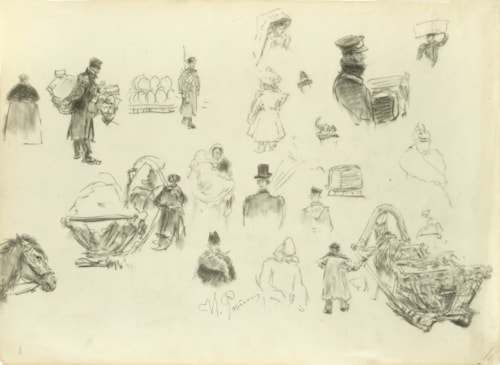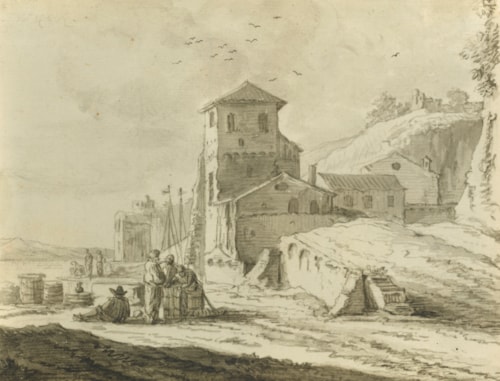chille Etna Michallon
(Paris 1796 - 1822)
A Castle on the Bosphorous
signed and dated 'Michallon/1816' and inscribed in Polish on the mount
brown wash over pencil on laid paper watermarked:..ANDERLEY, with original wash-line mount
33 x 46.5 cm (13 x 18⅓ in)
The sails of this formidable ship just catch the strong wind, as it tilts and breaks through the fierce waves. Achille Etna Michallon pays particular attention to the intricate detailing of the rigging on the three square-rigged masts above its ribbed hull. A figurehead stands out at the bow, whilst the crew work furiously at the stern to guide the magnificent ship along. Aloft the front mast is a flag, not that of the Ottomans, with its crescent and star, but a simple tricolor, indicating that it is either a French or Italian ship, both of which had strong trade links with Constantinople and saw merchants and their families taking up residence in the Pera region of the city.
The broad belly of this full rigged ship is accentuated by its wide horizontal bands and inside, its probable cargo of raw materials, such as wool, silk, cotton, alum, beeswax and animal hides, is being safely carried. The power of the rolling and breaking waves, as they froth around the hull, are deftly captured by Michallon. This is contrasted by the calmer waters near the shoreline, where other ships and gullets are moored. Above these, on a raised promontory, are the remains of a castle, with fortified walls reaching down to the sea - possibly the remnants of the sea walls which once enclosed the city of Constantinople on the sides of the Propontis (Sea of Marmara) and the gulf of the Golden Horn.
The notable distinction between the tranquillity and furious movements of the water suggests that this watercolour depicts the confluence of the calmer Bosphorus with either the Sea of Marmara or the Black Sea. As the only passage between the Black Sea and the Mediterranean, the Bosphorus was of great commercial and strategic importance and hence was the setting for numerous castles and forts, such as Yoros Castle.
This watercolour is one of a series of Turkish views drawn by Michallon for Edouard De Raczynski's volume on Turkey, Dziennik podrozy do Turcyi odbytey w Roku 1814, published in Warsaw in 1821, and in German in 1924.1 Another drawing of the Bosphorus from this series was sold in New York, Sotheby's, 25 January 2002, lot 115.
Michallon was the son of a sculptor, Claude Michallon (1751-1799). He grew up at the Louvre, where his family had a small apartment near his father's studio. At the age of six, Michallon had moved with his family to Sorbonne. Demonstrating a precocious talent, he began working in the studio of Jacques-Louis David, and then under Pierre-Henride Valenciennes who introduced him to landscape painting. At the age of just 15, Michallon exhibited at the Paris Salon where he won a second prize gold medal and at the age of 21 he was awarded the Prix de Rome for historical landscape painting.
He worked under the patronage of famous personalities, such as Prince Yussoupoff, the Duchess of Berry, the Count de L'Espine, all of whom were great admirers of his work. Michallon was considered a master of landscape painting and taught a circle of admiring young artists, one of them being Camille Corot.
His larger landscapes have been likened to Poussin and are marked by their drama and grandeur. His work from his period in Rome, between 1817 and 1821, shows the influence of Romanticism. He died of pneumonia at the early age of 26, leaving behind a large collection of studies, drawings and sketches and only a few finished canvases.
1see L. Navari, Greece and the Levant: the Catalogue of the Henry Myron Blackmer Collection of Books and Manuscripts, London 1989, no. 1375.
The sails of this formidable ship just catch the strong wind, as it tilts and breaks through the fierce waves. Achille Etna Michallon pays particular attention to the intricate detailing of the rigging on the three square-rigged masts above its ribbed hull. A figurehead stands out at the bow, whilst the crew work furiously at the stern to guide the magnificent ship along. Aloft the front mast is a flag, not that of the Ottomans, with its crescent and star, but a simple tricolor, indicating that it is either a French or Italian ship, both of which had strong trade links with Constantinople and saw merchants and their families taking up residence in the Pera region of the city.
The broad belly of this full rigged ship is accentuated by its wide horizontal bands and inside, its probable cargo of raw materials, such as wool, silk, cotton, alum, beeswax and animal hides, is being safely carried. The power of the rolling and breaking waves, as they froth around the hull, are deftly captured by Michallon. This is contrasted by the calmer waters near the shoreline, where other ships and gullets are moored. Above these, on a raised promontory, are the remains of a castle, with fortified walls reaching down to the sea - possibly the remnants of the sea walls which once enclosed the city of Constantinople on the sides of the Propontis (Sea of Marmara) and the gulf of the Golden Horn.
The notable distinction between the tranquillity and furious movements of the water suggests that this watercolour depicts the confluence of the calmer Bosphorus with either the Sea of Marmara or the Black Sea. As the only passage between the Black Sea and the Mediterranean, the Bosphorus was of great commercial and strategic importance and hence was the setting for numerous castles and forts, such as Yoros Castle.
This watercolour is one of a series of Turkish views drawn by Michallon for Edouard De Raczynski's volume on Turkey, Dziennik podrozy do Turcyi odbytey w Roku 1814, published in Warsaw in 1821, and in German in 1924.1 Another drawing of the Bosphorus from this series was sold in New York, Sotheby's, 25 January 2002, lot 115.
Michallon was the son of a sculptor, Claude Michallon (1751-1799). He grew up at the Louvre, where his family had a small apartment near his father's studio. At the age of six, Michallon had moved with his family to Sorbonne. Demonstrating a precocious talent, he began working in the studio of Jacques-Louis David, and then under Pierre-Henride Valenciennes who introduced him to landscape painting. At the age of just 15, Michallon exhibited at the Paris Salon where he won a second prize gold medal and at the age of 21 he was awarded the Prix de Rome for historical landscape painting.
He worked under the patronage of famous personalities, such as Prince Yussoupoff, the Duchess of Berry, the Count de L'Espine, all of whom were great admirers of his work. Michallon was considered a master of landscape painting and taught a circle of admiring young artists, one of them being Camille Corot.
His larger landscapes have been likened to Poussin and are marked by their drama and grandeur. His work from his period in Rome, between 1817 and 1821, shows the influence of Romanticism. He died of pneumonia at the early age of 26, leaving behind a large collection of studies, drawings and sketches and only a few finished canvases.
1see L. Navari, Greece and the Levant: the Catalogue of the Henry Myron Blackmer Collection of Books and Manuscripts, London 1989, no. 1375.





 contact
contact contact
contact +44 20 7313 8040
+44 20 7313 8040









